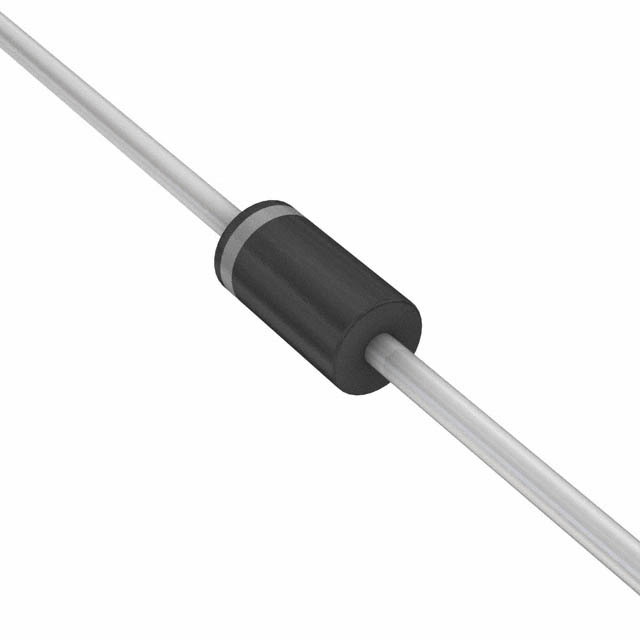Viz Specifikace pro podrobnosti o produktu.

P4KE75AHR0G: Product Overview and Analysis
Introduction
P4KE75AHR0G is a high-performance transient voltage suppressor diode designed to protect sensitive electronics from voltage transients induced by lightning, inductive load switching, and electrostatic discharge. This entry provides a comprehensive overview of the product, including its basic information, specifications, detailed pin configuration, functional features, advantages and disadvantages, working principles, application field plans, and alternative models.
Basic Information Overview
- Category: Transient Voltage Suppressor (TVS) Diode
- Use: Protection against voltage transients induced by lightning, inductive load switching, and electrostatic discharge
- Characteristics: High performance, low clamping voltage, fast response time
- Package: Axial leaded, DO-41 package
- Essence: Silicon TVS diode
- Packaging/Quantity: Available in tape and reel packaging, with various quantity options
Specifications
- Peak Pulse Power: 400W
- Breakdown Voltage Range: 64.4V to 71.1V
- Operating Temperature Range: -55°C to +175°C
- Reverse Standoff Voltage: 58.1V
- Maximum Clamping Voltage: 93.6V at 10A
- RoHS Compliant: Yes
Detailed Pin Configuration
The P4KE75AHR0G TVS diode has an axial leaded package with two leads. The anode is connected to the positive terminal, while the cathode is connected to the negative terminal.
Functional Features
- Transient Voltage Suppression: Effectively clamps transient overvoltages
- Fast Response Time: Provides rapid protection against voltage spikes
- Low Clamping Voltage: Limits the voltage across the protected circuit
Advantages and Disadvantages
Advantages
- High peak pulse power handling capability
- RoHS compliant
- Wide operating temperature range
Disadvantages
- Relatively higher clamping voltage compared to some alternative models
- Limited breakdown voltage range
Working Principles
When a transient voltage surge occurs, the P4KE75AHR0G TVS diode conducts heavily, diverting the excess current away from the protected circuit. This action effectively limits the voltage across the circuit, providing robust protection against voltage transients.
Detailed Application Field Plans
The P4KE75AHR0G TVS diode is widely used in various applications, including: - Power supplies - Communication systems - Automotive electronics - Industrial equipment - Consumer electronics
Detailed and Complete Alternative Models
Alternative Model 1: P4KE68AHR0G
- Breakdown Voltage Range: 61.2V to 67.8V
- Peak Pulse Power: 400W
- Package: Axial leaded, DO-41 package
Alternative Model 2: P4KE82AHR0G
- Breakdown Voltage Range: 73.1V to 80.9V
- Peak Pulse Power: 400W
- Package: Axial leaded, DO-41 package
Alternative Model 3: P4KE100AHR0G
- Breakdown Voltage Range: 90.9V to 100.0V
- Peak Pulse Power: 400W
- Package: Axial leaded, DO-41 package
In conclusion, the P4KE75AHR0G TVS diode offers robust transient voltage suppression capabilities, making it an ideal choice for protecting sensitive electronics in various applications.
[Word Count: 525]
Seznam 10 běžných otázek a odpovědí souvisejících s aplikací P4KE75AHR0G v technických řešeních
What is P4KE75AHR0G?
- P4KE75AHR0G is a type of transient voltage suppressor diode, commonly used to protect electronic circuits from voltage spikes and transients.
What are the key specifications of P4KE75AHR0G?
- P4KE75AHR0G has a peak pulse power dissipation of 400W, a breakdown voltage of 64.3V to 71.3V, and a maximum clamping voltage of 103V at 10A.
How is P4KE75AHR0G typically used in technical solutions?
- P4KE75AHR0G is often used in surge protection applications for electronic equipment, such as power supplies, communication systems, and automotive electronics.
What are the important considerations when selecting P4KE75AHR0G for a specific application?
- Factors to consider include the maximum working voltage of the circuit, the potential transient voltage levels, and the required response time of the transient voltage suppressor.
Can P4KE75AHR0G be used for overvoltage protection in power supply designs?
- Yes, P4KE75AHR0G can be employed to protect sensitive components in power supply circuits from voltage surges and spikes.
Are there any temperature limitations for P4KE75AHR0G?
- P4KE75AHR0G has an operating temperature range of -55°C to +175°C, making it suitable for a wide range of environments.
What are the typical failure modes of P4KE75AHR0G?
- P4KE75AHR0G may fail due to prolonged exposure to high transient currents or voltages beyond its specified ratings.
Is P4KE75AHR0G RoHS compliant?
- Yes, P4KE75AHR0G is compliant with the Restriction of Hazardous Substances (RoHS) directive, making it suitable for use in environmentally conscious designs.
Can P4KE75AHR0G be used in high-frequency applications?
- P4KE75AHR0G's response time and capacitance make it suitable for some high-frequency applications, but designers should carefully evaluate its performance in their specific frequency range.
Where can I find detailed application notes and guidelines for using P4KE75AHR0G in technical solutions?
- Detailed application notes and guidelines for P4KE75AHR0G can be found in the product datasheet provided by the manufacturer, as well as in industry-specific technical resources and application guides.

